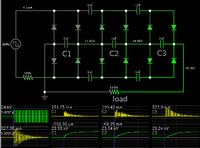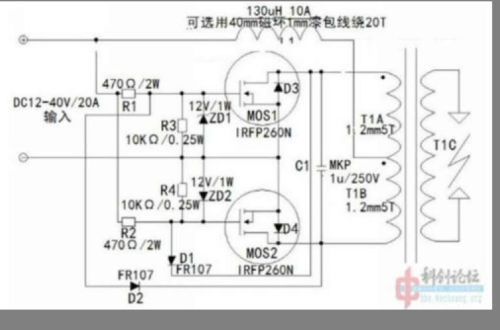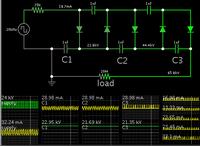Blasterg
Newbie level 4
Good night, had a few questions about the design of a high voltage power supply...
I'm currently in the development stage of a power supply for a tube of X-rays, the initial voltage will come out from a source of 24V 10A DC, which fed a ZVS driver for a flyback, which will output approximately 24kV, which is not a negligible amount, and my tube (CEI OX / 70-G4) will work fine, but I would add a CW multiplier to achieve an output of at least 65-70kV (since the tube has a rated voltage 75KV), could help me to calculate the number of phases and specifications that should have the diodes and capacitors please? : /
By my calculations, 2 phases suffice to raise the voltage from 24kV to 67.88kV, but I'm a little confused with the diodes and capacitors that I should use.
By the way, I still do not have in my hands the power supply to deliver the initial voltage, it's a Meanwell S-250-24
I noticed that comes with a potentiometer to adjust the output voltage, and I was thinking maybe I could take him down to 15V, is this possible?
Because in that case I would use these 15V to have an output of approximately 15kV on the flyback and then use a CW multiplier of 4 phases and obtain 84.85kV, which would come to be 75-78kV for losses.
Help please!
BTW, sorry for my english, my native language is spanish.
I'm currently in the development stage of a power supply for a tube of X-rays, the initial voltage will come out from a source of 24V 10A DC, which fed a ZVS driver for a flyback, which will output approximately 24kV, which is not a negligible amount, and my tube (CEI OX / 70-G4) will work fine, but I would add a CW multiplier to achieve an output of at least 65-70kV (since the tube has a rated voltage 75KV), could help me to calculate the number of phases and specifications that should have the diodes and capacitors please? : /
By my calculations, 2 phases suffice to raise the voltage from 24kV to 67.88kV, but I'm a little confused with the diodes and capacitors that I should use.
By the way, I still do not have in my hands the power supply to deliver the initial voltage, it's a Meanwell S-250-24
I noticed that comes with a potentiometer to adjust the output voltage, and I was thinking maybe I could take him down to 15V, is this possible?
Because in that case I would use these 15V to have an output of approximately 15kV on the flyback and then use a CW multiplier of 4 phases and obtain 84.85kV, which would come to be 75-78kV for losses.
Help please!
BTW, sorry for my english, my native language is spanish.




